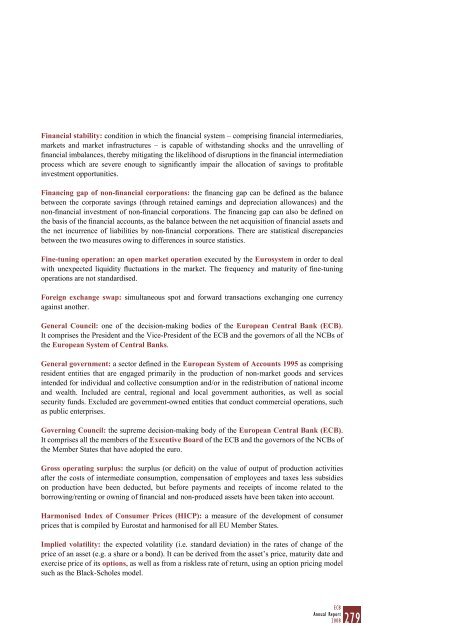ANNUAL REPORT 2008 - Polymer Bank Notes of the World
ANNUAL REPORT 2008 - Polymer Bank Notes of the World
ANNUAL REPORT 2008 - Polymer Bank Notes of the World
You also want an ePaper? Increase the reach of your titles
YUMPU automatically turns print PDFs into web optimized ePapers that Google loves.
Financial stability: condition in which <strong>the</strong> financial system – comprising financial intermediaries,markets and market infrastructures – is capable <strong>of</strong> withstanding shocks and <strong>the</strong> unravelling <strong>of</strong>financial imbalances, <strong>the</strong>reby mitigating <strong>the</strong> likelihood <strong>of</strong> disruptions in <strong>the</strong> financial intermediationprocess which are severe enough to significantly impair <strong>the</strong> allocation <strong>of</strong> savings to pr<strong>of</strong>itableinvestment opportunities.Financing gap <strong>of</strong> non-financial corporations: <strong>the</strong> financing gap can be defined as <strong>the</strong> balancebetween <strong>the</strong> corporate savings (through retained earnings and depreciation allowances) and <strong>the</strong>non-financial investment <strong>of</strong> non-financial corporations. The financing gap can also be defined on<strong>the</strong> basis <strong>of</strong> <strong>the</strong> financial accounts, as <strong>the</strong> balance between <strong>the</strong> net acquisition <strong>of</strong> financial assets and<strong>the</strong> net incurrence <strong>of</strong> liabilities by non-financial corporations. There are statistical discrepanciesbetween <strong>the</strong> two measures owing to differences in source statistics.Fine-tuning operation: an open market operation executed by <strong>the</strong> Eurosystem in order to dealwith unexpected liquidity fluctuations in <strong>the</strong> market. The frequency and maturity <strong>of</strong> fine-tuningoperations are not standardised.Foreign exchange swap: simultaneous spot and forward transactions exchanging one currencyagainst ano<strong>the</strong>r.General Council: one <strong>of</strong> <strong>the</strong> decision-making bodies <strong>of</strong> <strong>the</strong> European Central <strong>Bank</strong> (ECB).It comprises <strong>the</strong> President and <strong>the</strong> Vice-President <strong>of</strong> <strong>the</strong> ECB and <strong>the</strong> governors <strong>of</strong> all <strong>the</strong> NCBs <strong>of</strong><strong>the</strong> European System <strong>of</strong> Central <strong>Bank</strong>s.General government: a sector defined in <strong>the</strong> European System <strong>of</strong> Accounts 1995 as comprisingresident entities that are engaged primarily in <strong>the</strong> production <strong>of</strong> non-market goods and servicesintended for individual and collective consumption and/or in <strong>the</strong> redistribution <strong>of</strong> national incomeand wealth. Included are central, regional and local government authorities, as well as socialsecurity funds. Excluded are government-owned entities that conduct commercial operations, suchas public enterprises.Governing Council: <strong>the</strong> supreme decision-making body <strong>of</strong> <strong>the</strong> European Central <strong>Bank</strong> (ECB).It comprises all <strong>the</strong> members <strong>of</strong> <strong>the</strong> Executive Board <strong>of</strong> <strong>the</strong> ECB and <strong>the</strong> governors <strong>of</strong> <strong>the</strong> NCBs <strong>of</strong><strong>the</strong> Member States that have adopted <strong>the</strong> euro.Gross operating surplus: <strong>the</strong> surplus (or deficit) on <strong>the</strong> value <strong>of</strong> output <strong>of</strong> production activitiesafter <strong>the</strong> costs <strong>of</strong> intermediate consumption, compensation <strong>of</strong> employees and taxes less subsidieson production have been deducted, but before payments and receipts <strong>of</strong> income related to <strong>the</strong>borrowing/renting or owning <strong>of</strong> financial and non-produced assets have been taken into account.Harmonised Index <strong>of</strong> Consumer Prices (HICP): a measure <strong>of</strong> <strong>the</strong> development <strong>of</strong> consumerprices that is compiled by Eurostat and harmonised for all EU Member States.Implied volatility: <strong>the</strong> expected volatility (i.e. standard deviation) in <strong>the</strong> rates <strong>of</strong> change <strong>of</strong> <strong>the</strong>price <strong>of</strong> an asset (e.g. a share or a bond). It can be derived from <strong>the</strong> asset’s price, maturity date andexercise price <strong>of</strong> its options, as well as from a riskless rate <strong>of</strong> return, using an option pricing modelsuch as <strong>the</strong> Black-Scholes model.ECBAnnual Report<strong>2008</strong>279




![KNOW YOUR NEW GIBRALTAR BANKNOTES - [Home] bThe/b](https://img.yumpu.com/50890985/1/184x260/know-your-new-gibraltar-banknotes-home-bthe-b.jpg?quality=85)
![PAPUA NEW GUINEA - [Home] - Polymer Bank Notes of the World](https://img.yumpu.com/49758743/1/190x143/papua-new-guinea-home-polymer-bank-notes-of-the-world.jpg?quality=85)










